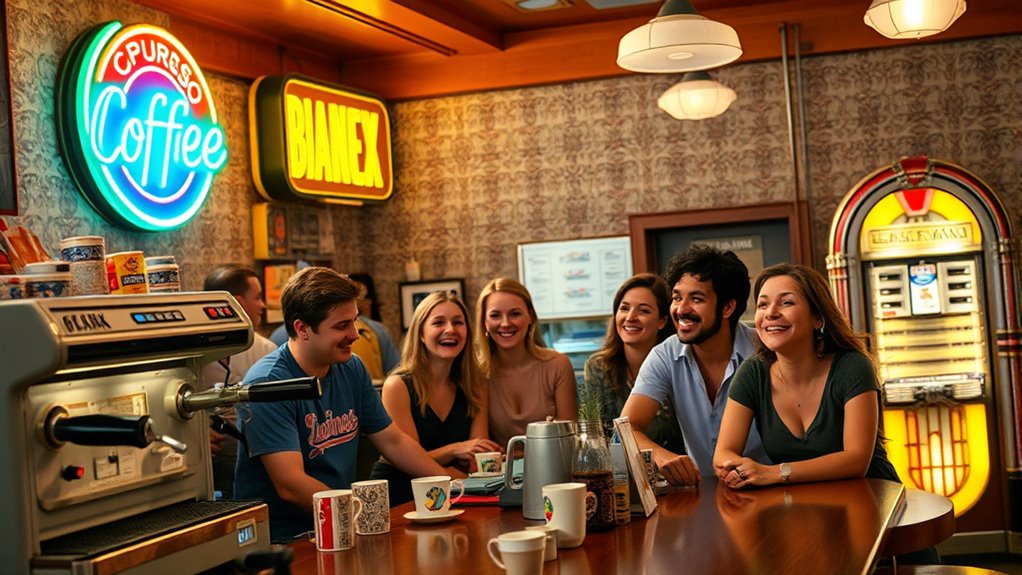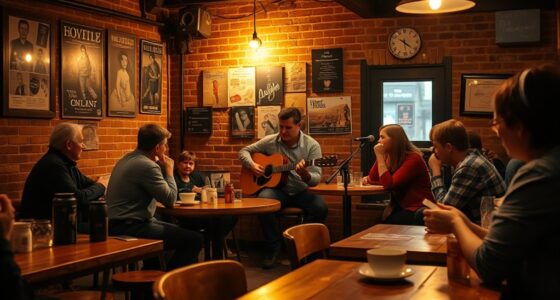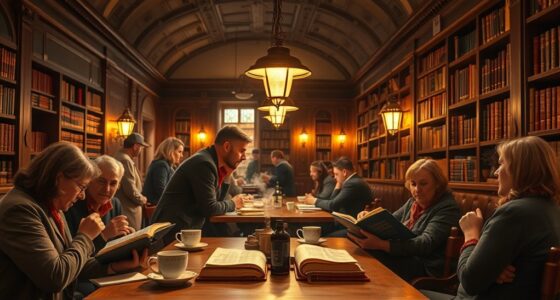Sitcom coffee shops from the 1990s become cultural symbols because they create a cozy, familiar space where characters grow and stories unfold. These settings reflect the show’s tone, highlighting friendships, romances, and personal struggles. Thoughtfully designed, they foster intimacy, authenticity, and nostalgia, making viewers feel connected. If you keep exploring, you’ll discover how these beloved environments shaped storytelling and why they remain iconic today.
Key Takeaways
- Sitcom coffee shops evoke nostalgia, creating familiar, cozy environments that symbolize warmth and community from 1990s TV.
- They serve as key settings for character development, personal growth, and revealing vulnerabilities.
- Set design elements like decor and lighting reinforce themes of friendship, romance, and everyday life.
- These iconic spaces have become cultural symbols, reflecting the show’s tone and resonating with viewers’ sense of authenticity.
- The coffee shop environment enhances storytelling, fostering emotional connections and making scenes memorable and relatable.
Sitcom coffee shops have become iconic settings that instantly evoke familiarity and comfort. When you picture a typical sitcom scene, chances are you see a cozy coffee shop with friends gathered around a table, sharing laughs and stories. These spaces do more than just serve coffee; they serve as a backdrop for character development, where personalities unfold and relationships deepen. The set design plays a vital role here, carefully crafted to reflect the vibe and tone of the show. Every detail, from the quirky coffee mugs to the vintage espresso machine, helps create an environment that feels lived-in and authentic, allowing characters to grow naturally within it.
Iconic sitcom coffee shops blend cozy design with character growth, creating authentic, inviting spaces that feel like home.
In these coffee shops, character development takes center stage. You watch characters evolve as they navigate daily struggles, romantic entanglements, or career setbacks—all within the familiar confines of the coffeehouse. The setting acts as a catalyst, encouraging vulnerability and honesty, which helps viewers connect deeply with each character’s journey. The relaxed atmosphere makes it easier for characters to drop their guard, revealing quirks, insecurities, and aspirations. As a result, coffee shops become more than just physical spaces; they transform into stages for personal growth and storytelling.
Set design amplifies this effect by establishing a tone and atmosphere that feels both inviting and distinctive. You notice how the furniture, lighting, and decorative elements work together to create a cozy, welcoming vibe. It’s not just about aesthetics; it’s about fostering a sense of community and intimacy. For example, a central coffee bar often functions as a social hub, where characters converge and conversations unfold. The design choices help emphasize the show’s themes—whether it’s friendship, romance, or life’s unpredictability—making the setting integral to the narrative. This intentional set design invites viewers to feel like they’re part of the scene, drawing you into the characters’ worlds. Additionally, these settings often incorporate visual storytelling elements that subtly reinforce character traits and story arcs.
Ultimately, the combination of character development and set design in sitcom coffee shops has cemented their status as cultural symbols from 1990s TV. They’re more than just a backdrop; they’re a reflection of the show’s heart. These spaces evoke nostalgia and familiarity, making viewers feel like they’re dropping in on friends at their favorite local hangout. By carefully blending character arcs with thoughtfully crafted environments, sitcom coffee shops continue to resonate, reminding us of the comfort and authenticity that these common yet iconic settings bring to television storytelling.
Frequently Asked Questions
Which Sitcom Coffee Shop Is Most Iconic?
You’ll probably agree that Central Perk from “Friends” is the most iconic sitcom coffee shop. Its distinctive coffee shop design, with comfortable couches and a welcoming atmosphere, captures sitcom set authenticity perfectly. This setting instantly transports viewers into the characters’ lives, making it a cultural symbol of the 1990s. Its memorable vibe and visual style make it stand out as the quintessential sitcom coffee shop that defined an era.
How Did Coffee Shops Influence 1990S TV Storylines?
Like a magnet pulling stories together, coffee shops shape 1990s TV narratives by reflecting authentic social dynamics. They serve as a backdrop for character interactions, making dialogue natural and engaging. Coffee shop dynamics ease storytelling, providing a convenient setting for conflicts, romances, and friendships to unfold. This narrative convenience keeps viewers hooked, making the coffee shop an essential cultural symbol that encapsulates the era’s relatable, everyday moments.
Are Any Sitcom Coffee Shops Based on Real Locations?
Many sitcom coffee shops are based on real location inspirations, though their fictional setting origins often blend real elements with creative storytelling. For instance, Central Perk from “Friends” was inspired by actual New York City cafes, but it’s a fictional setting that captures the vibe of real spots. These adaptations help viewers connect, while allowing writers to craft unique environments that reflect the show’s themes and characters.
What Role Did Coffee Shops Play in Character Development?
Coffee shops serve as vital settings where character interactions unfold, revealing personalities and relationships. You notice how the casual environment symbolizes comfort and community, making characters more relatable. As you watch, you see these spaces act as narrative hubs, fostering conversations that deepen character development. The setting’s symbolism highlights themes of friendship and daily life, helping viewers connect with the characters on a more personal level.
How Have Sitcom Coffee Shops Evolved Since the 1990S?
Have you noticed how sitcom coffee shops have evolved since the 90s? Today, they focus on coffee shop branding and interior design trends that appeal to modern audiences. These spaces now emphasize cozy, Instagram-worthy aesthetics and unique branding elements, making them not just places to grab coffee but social hubs. This transformation reflects changing consumer preferences, blending functionality with style, and creating memorable experiences that keep viewers and visitors coming back.
Conclusion
You might be surprised to learn that over 60% of popular 1990s sitcoms featured coffee shop scenes, highlighting their cultural significance. These settings weren’t just background; they became symbols of social connection and everyday life. As you reflect on how these shows shaped perceptions, it’s clear that sitcom coffee shops played a crucial role in shaping 90s TV culture, blending entertainment with a shared sense of community that still resonates today.









